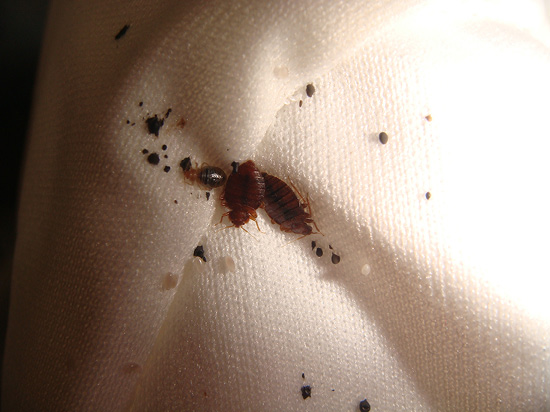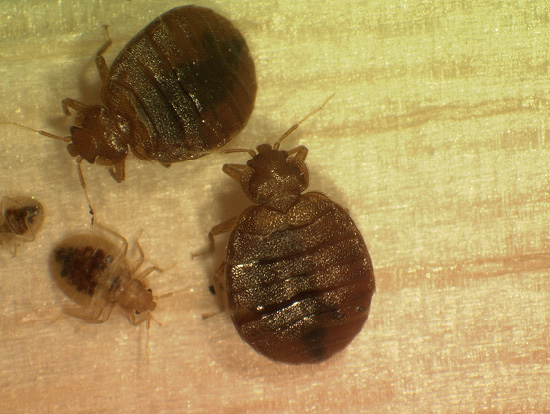Combatting Bed Bugs in Broiler Breeder Houses
Bed Bug Background
Bed bugs have made a major comeback over the past 25 years in the U.S., and this is causing serious problems in many poultry broiler breeder flocks. Bed bugs (Cimex lectularius) are hematophagous (feed on blood) parasites that are increasingly more common today, after becoming quite scarce during the second half of the 20th century. In fact, bed bugs were thought to be largely eradicated from the U.S. for several decades following World War II, existing only in a few small pockets (Cranshaw et al., 2013). This was likely because most of them were effectively controlled by widespread use of DDT and other broad-spectrum insecticides in the 1940s and 1950s (Tabler et al., 2015).
Unfortunately, while infestations worldwide were declining, insecticide resistance was occurring in a small part of the bed bug population. Today, insecticide resistance has become a worldwide problem reported in hundreds of insect species. This includes pyrethroid resistance, which has recently been reported in populations of bed bugs and has been implicated as one of the many factors in the current resurgence of these insects (Gordon et al., 2014).
Bed bugs belong to the Cimicidae family of insects. Members of this family are small, oval, flat, hard-bodied, flightless insects in which the wings are absent or reduced to stubs (Figure 1). All members of this insect family feed on blood. Bed bugs have been a problem since before the beginning of recorded time. They have been unearthed from archeological sites dating back more than 3,500 years. They hitched a ride to the U.S. aboard ships of the first European explorers and settlers, and gradually moved inland from the coast. The latest resurgence of bed bugs in the U.S. has followed a similar pattern, with initial reports of infestations in the late 1990s appearing in such costal locations as New York, San Francisco, and Miami (Potter, 2011).

Much like in human dwellings, bed bugs in broiler breeder houses are active late at night, often just before dawn. You will likely not see them during the day unless you have a huge infestation because they prefer to remain hidden during the day and only come out to feed after dark. Unlike fowl mites, they only remain on the chickens long enough to feed and then leave and go back into hiding. Feeding does not take long—the insect will become satiated in no more than 10–12 minutes. It then returns to its hiding area to digest its meal.
Bed Bug Biology
The bed bug life cycle consists of the egg, five stages of nymphs (each progressively larger than the preceding stage), and adult (Steelman, 2000). In order to develop from one stage to the next, each immature nymph must take regular blood meals to continue to develop. Bed bugs are obligate parasites, meaning they cannot survive without feeding on the blood of their hosts. However, they are capable of going extremely long periods between feedings if need be; perhaps up to a year or more. It is useless to try to starve them to death; they can hold out longer than you. Adult bed bugs must also take a blood meal to continue to reproduce, as a blood meal is required for production of each batch of eggs by the female. Adult bed bugs are reddish-brown, while nymphs and eggs are white to yellowish (Figure 2).
Female bed bugs cement their small, oval eggs in batches of two to five eggs. A female bed bug may lay 50 to 350 eggs in her lifetime, depending on environmental conditions. Eggs generally hatch in 6–10 days, although this is temperature-dependent. At temperatures above 70°F, eggs can hatch in 6–17 days; while lower temperatures may delay hatching up to 28 days (Roe, 2000). Newly hatched nymphs will immediately seek out a food source if it is available. And in a broiler breeder flock, the chickens are the food source and supply the blood meal. Feeding occurs in the dark, usually in the middle of the night and on toward dawn. The bed bug uses the presence of carbon dioxide and heat to locate its host.

Photo by Miller and Stedfast, Virginia Tech Entomology.
It requires about 4 days between nymph stages at a temperature of 80°F. Therefore, the entire life cycle from egg to adult requires about 30 days (Steelman, 2000). Adults typically live for about 9 months. Under ideal conditions, each adult generally will feed once a week, and many feedings occur during its lifespan (Jacobs, 2015). However, cooler temperatures retard development, and activity level declines as the temperature drops below 60°F.
Again, however, bed bugs are very resistant to starvation, and both nymphs and adults can survive several months without a blood meal. Nymphs can tolerate starvation for about 3 months, while some adults have been known to survive for a year without feeding. Unfortunately, this makes it possible for a bed bug infestation in a broiler breeder house to very easily survive the downtime period between one breeder flock and the next. Again, the bugs will not starve to death while you are out of birds between flocks. Once the old flock leaves, the bugs just wait for the new flock to arrive and then begin feeding again. Therefore, you must take steps between flocks to knock the population back as much as possible and, when the new flock arrives, continue with a regular treatment program designed around when birds are in the house.
Resurgence and Control
Although not all the factors related to the recent resurgence in bed bug populations are known or understood, it is suspected that increased long-range air travel, a reduction in the use of residual insecticides, movement of bed bugs from birds to bats to humans, and the ability of bed bugs to disperse locally all play a role (Steelman et al., 2008). Passive dispersal is the most important method for bed bugs to reach new hosts. Bed bugs are excellent hitchhikers and, in a poultry house situation, are easily transported from infested facilities on human shoes, clothes, cardboard egg boxes, and egg buggies that transport eggs to the hatchery and may then be carried on to other farms (Steelman, 2000). Egg buggies coming from an infested farm must be carefully cleaned and inspected before being sent out again to prevent infecting other farms.
It only takes one impregnated female being moved onto a clean farm to produce a well-developed infestation in a broiler-breeder house within only a few months. A male is not required if the female was impregnated when the move occurred. Even though she will eventually run out of sperm and have to mate again to fertilize additional eggs, she can mate with her own offspring after they become adults. With access to a host (which is usually the case in a breeder house) and under the proper environmental conditions, because of the large number of eggs that a female can lay, bed bug populations can eventually double every 16 days (Tabler et al., 2015).
Bed bugs are extremely difficult to control in a breeder house setting. Extreme care must be taken to prevent them from moving from the chicken house to your dwelling house on shoes, clothing, purses, or other personal items. They are, for the most part, nocturnal. Therefore, you may not know you have a problem with them until numbers increase to such high levels that you begin to see them in the day time or they begin to show up on eggs or on workers gathering the eggs. Even though they prefer to avoid light, when numbers become extremely high, you will see them during the day. However, by the time bug numbers reach this level, you have a problem that is out of control.
Unfortunately, there are few effective classes of insecticides available today to treat against bed bugs, in part because the predominant use of pyrethroid-based products has resulted in resistance in most bed bug populations. In addition, to be successful, insecticide applications must reach the cracks, crevices, and hiding places that act as harborage sites for the bugs, which is sometimes difficult. Some products are contact sprays, meaning they will only work when they come in contact with the bed bug. Unfortunately, because bed bugs stay hidden most of the time, contact sprays are not the best treatment option in most cases. Also, labeling restrictions often limit the number of products that can be applied with birds in the house.
As a result, it is often easier to gain control of an infestation when the farm is out of birds and more potent products can be used to combat the infestation. Afterward, spraying on a regular basis with products labeled for use with birds on the farm can help keep the bed bug population knocked back. Keep in mind that most insecticides do not kill eggs, so spraying may need to occur more often initially (perhaps every 2 weeks) to get the population under control. Products that can be used with birds on the farm include permethrin formulations, Ravap EC (tetrachlorvinphos and dichlorvos), and Rabon.
There are a few products labeled for use when birds are absent and the houses empty that have proven useful in combatting bed bugs. Some of these include Optimate (gamma-cyhalothrin), Durashield CS (chlorpyrifos), BP-100 (pyrethrins and piperonyl butoxide), Grenade (lambda-cyhalothrin), and Phantom (chlorfenapyr). Some animal-health supply companies have developed bed bug treatment programs for use on breeder farms between flocks and when birds are present. If you have a bed bug problem on your farm, check with your integrator or animal health supplier for a treatment program. It is likely that no treatment program can totally eradicate every single bed bug from a breeder house (there are simply too many hiding places), but there are programs that can keep bed bug numbers at manageable levels.
For a nonchemical alternative, heat treatment can be used to kill bed bugs when birds are absent from the farm. Sustained heating of the house to 130°F for a few hours should kill the bed bugs and their eggs. However, care must be taken if using heat to make sure you do not set the house on fire. Before heat treating, an outside-perimeter, residual insecticide should be applied to kill any bed bugs trying to escape from the heat.
Precaution: Not every chemical insecticide may be legal in every state. Check with your integrator, local county MSU Extension office, or other regulatory official before using any insecticide in or around your poultry houses. Even if a product is legal for use in your state, CHECK WITH YOUR INTEGRATOR before using to make sure it is on their approved list of products deemed safe for use in or around chicken houses. READ AND FOLLOW ALL LABEL DIRECTIONS FOR SAFE USE OF ANY PESTICIDE. Also, use your common sense. Pesticides are poisons, so take necessary precautions, handle carefully, store in original labeled containers, and keep out of reach of children, pets, and livestock. Do not contaminate water supplies, streams, or ponds. Dispose of empty containers in a safe and approved manner and location.
Summary
Bed bugs are very difficult to combat in a poultry breeder house situation. Even though they have existed for thousands of years, most people had never seen one until recently. This includes many entomologists and pest-control personnel. However, over the last 25 years, they have made a dramatic comeback in both human dwellings and broiler-breeder houses. They have developed resistance to almost every insecticide used against them, making them extremely difficult to eradicate. Hiding places are numerous in a breeder house, making the task of controlling them that much more difficult. They are excellent hitchhikers, allowing them to easily move from farm to farm or farm to home. Extreme caution must be taken by integrators to prevent transporting bugs from farm to farm on egg buggies. Growers with infested breeder houses must also exercise extreme care not to track the bugs to their homes.
References
Cranshaw, W. S., M. Camper, and F. Peairs. 2013. Bat bugs, bed bugs, and relatives. Fact Sheet 5.574. Insect series. Colorado State University Extension.
Gordon, J. R., M. H. Goodman, M. F. Potter, and K. F. Haynes. 2014. Population variation in and selection for resistance to pyrethroid-neonicotinoid insecticides in the bed bug. Sci. Rep. 4,3836; DOI:10.1038/srep03836.
Jacobs, S. B. 2015. Bed bugs. Entomological Notes. PH-1. College of Agricultural and Life Sciences. Cooperative Extension. Penn State University. State College, PA.
Potter, M. F. 2011. The history of bed bug management: With lessons from the past. American Entomologist. 57(1):14-25. Spring 2011.
Roe, A. H. 2000. Bed Bugs. Utah State University Extension Fact Sheet No. 93. April.
Steelman, C. D. 2000. Biology and control of bed bugs. Avian Advice. Vol. 2(2):10, 15. University of Arkansas Cooperative Extension Service. Winter.
Steelman, C. D., A. L. Szalanski, R. Trout, J. A. McKern, C. Solorzano, and J. W. Austin. 2008. Susceptibility of the bed bug Cimex lectularius L. (Heteroptera: Cimicidae) collected in poultry production facilities to selected pesticides. J. Agric. Urban Entomol. 25(1):41-51.
Tabler, T., K. M. Loftin, M. Farnell, J. Wells, and H. M. Yakout. 2015. Bed bugs: Difficult pests to control in poultry breeder flocks. Publ. 2881. Mississippi State University Extension Service. March.
The information given here is for educational purposes only. References to commercial products, trade names, or suppliers are made with the understanding that no endorsement is implied and that no discrimination against other products or suppliers is intended.
Publication 3293 (POD-04-21)
By Tom Tabler, former Extension Professor, Poultry Science; Kelly M. Loftin, Extension Entomologist, University of Arkansas Cooperative Extension Service; and Jessica Wells, Assistant Clinical/Extension Professor, Poultry Science.
The Mississippi State University Extension Service is working to ensure all web content is accessible to all users. If you need assistance accessing any of our content, please email the webteam or call 662-325-2262.




